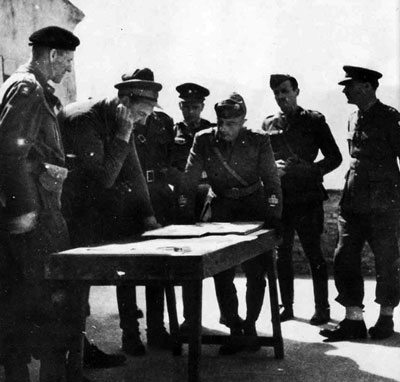
General Utili (centre hands of table) meets with Italian and British staff.
The Italian Liberation Corps (CIL), formed in Apulia, was directed north by Allied Headquarters in October 1943. It first saw action on December 8, 1943. American headquarters ordered it to seize Monte Lungo and Monte Sammucro. The initial attempt failed. The second, on December 16, succeeded. The CIL was then sent to the rear and remained inactive and in very poor condition until February 1944. In January 1944, Marshal Giovanni Messe, former commander of Italian troops in Tunisia, was permitted to return to Italy from British internment, as chief of staff. He appointed General Umberto Utili commander of CIL. Utili completely reorganized CIL; and it returned to the front in March 1944 in the Mainarde Mountains sector. After several engagements, CIL was increased to 25,000 men. Allied headquarters dispatched it to Abruzzo, and from there it gradually fought its way to Marche. Alongside British and Polish units, it faced the German LXXVI Corps. On September 24, 1944, it was dissolved. Why?
After liberating Rome on June 4, 1944, and following the landings in Normandy and Provence, Allied troops needed as many men as possible in France. Approximately 43,000 Italian prisoners had been shipped from North African camps to southern France to provide rear-area support. Free French forces had also been moved from Italy to France, and Allied operations in Italy needed to fill gaps in the front. On July 23, 1944, the Regio Esercito was ordered to provide two Italian combat groups. They were organized and equipped along British lines. Demand for troops quickly resulted in the expansion of the Italian combat groups to four, with a fifth as a training unit. Each combat group had 8,758 men, British equipment, and British inspectors.
The Allied headquarters perceived the situation as problematic. The CIL was growing. It had no British inspectors but was fighting very well. Its strength was going to be equivalent to an Allied corps, but this would have meant permitting the Italian Army to act as an ally. This had to remain impossible. Italy was a defeated enemy and only necessity led the Allies to give the Italians the honor of cobelligerent status, a newly invented term, which did not imply alliance. Combat groups meant Italian forces now increased from 25,000 to 50,000 men. But the doubling of combat strength did not translate into the establishment of an Italian army operating on its own front. In fact, each combat group, equal to a division, was scattered among British and American armies. So the Italian General Staff and the group commanders had no role in planning operations, they could merely carry out their orders. Thus they could not ask for being considered real Allies.
Combat groups fought in the last campaigns of the war and, in April 1945, took part in the final Allied offensive in Italy. Field Marshal Alexander had twenty-two divisions and seven brigades at his disposal. In the early days of April he engaged Kesselring’s Armies Group C with twenty divisions and the National Republican Armed Forces. While the Germans surrendered, Italian Republican units fought to their last round against the Yugoslavs and the French.
Italy’s odd political situation led to significant fighting by partisan together with Fascist units against French troops coming through the Alps to seize the Aosta Valley. On the other side of Italy, Fascist Republican units fought in Friuli, Istria, Dalmatia, and Carniola, against Yugoslav partisans. Italians succeeded in the west thanks to American pressure on the French government. They failed, however, in Friuli, because the Eighth Army moved too slowly and, due to the agreements at Yalta in February 1945, Istria and Dalmatia were lost to Yugoslavia.
During the last days of war, on April 25, 1945, partisans captured and killed Mussolini and all the Fascist hierarchs they could find. The Duce’s body was promptly displayed hanging by his feet in Milan, while his documents disappeared. Republican troops disbanded. Most of the soldiers were massacred by partisans. According to reliable figures, of the 25,000 dead belonging to the Republican armed forces, some 15,000 were killed after April 25, 1945, that is to say, after the official conclusion of the war.